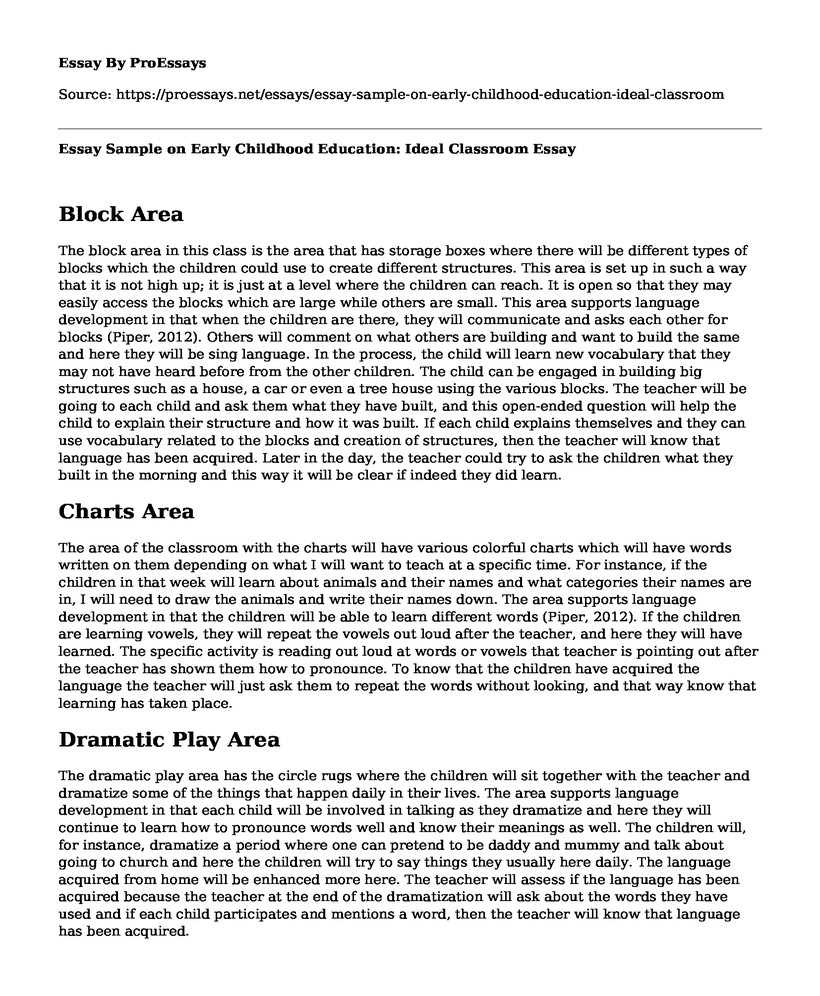Block Area
The block area in this class is the area that has storage boxes where there will be different types of blocks which the children could use to create different structures. This area is set up in such a way that it is not high up; it is just at a level where the children can reach. It is open so that they may easily access the blocks which are large while others are small. This area supports language development in that when the children are there, they will communicate and asks each other for blocks (Piper, 2012). Others will comment on what others are building and want to build the same and here they will be sing language. In the process, the child will learn new vocabulary that they may not have heard before from the other children. The child can be engaged in building big structures such as a house, a car or even a tree house using the various blocks. The teacher will be going to each child and ask them what they have built, and this open-ended question will help the child to explain their structure and how it was built. If each child explains themselves and they can use vocabulary related to the blocks and creation of structures, then the teacher will know that language has been acquired. Later in the day, the teacher could try to ask the children what they built in the morning and this way it will be clear if indeed they did learn.
Charts Area
The area of the classroom with the charts will have various colorful charts which will have words written on them depending on what I will want to teach at a specific time. For instance, if the children in that week will learn about animals and their names and what categories their names are in, I will need to draw the animals and write their names down. The area supports language development in that the children will be able to learn different words (Piper, 2012). If the children are learning vowels, they will repeat the vowels out loud after the teacher, and here they will have learned. The specific activity is reading out loud at words or vowels that teacher is pointing out after the teacher has shown them how to pronounce. To know that the children have acquired the language the teacher will just ask them to repeat the words without looking, and that way know that learning has taken place.
Dramatic Play Area
The dramatic play area has the circle rugs where the children will sit together with the teacher and dramatize some of the things that happen daily in their lives. The area supports language development in that each child will be involved in talking as they dramatize and here they will continue to learn how to pronounce words well and know their meanings as well. The children will, for instance, dramatize a period where one can pretend to be daddy and mummy and talk about going to church and here the children will try to say things they usually here daily. The language acquired from home will be enhanced more here. The teacher will assess if the language has been acquired because the teacher at the end of the dramatization will ask about the words they have used and if each child participates and mentions a word, then the teacher will know that language has been acquired.
Reference
Piper, T. (2012). Making meaning, making sense: Children's early language learning. Retrieved from https://content.ashford.edu/
Cite this page
Essay Sample on Early Childhood Education: Ideal Classroom. (2022, Nov 16). Retrieved from https://proessays.net/essays/essay-sample-on-early-childhood-education-ideal-classroom
If you are the original author of this essay and no longer wish to have it published on the ProEssays website, please click below to request its removal:
- The Grieving India Essay Example
- Essay Example on Student Loans: Necessity or Misuse?
- Learner-Centered Teaching: Meeting Individual Learning Needs - Research Proposal
- Essay on Parent Engagement: Key to Student Success & Learning Efficiency
- Advertising Rewires Kids' Minds: The Biological Effects on Child Development - Essay Sample
- Paper Sample: Fresh Graduate Pursues Master's in Electrical Engineering at KFUPM
- Free Paper Sample: Interest in Education Assistant Role







